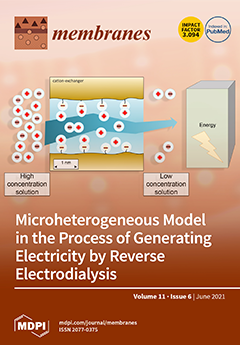Biological membranes are complex dynamic systems composed of a great variety of carbohydrates, lipids, and proteins, which together play a pivotal role in the protection of organisms and through which the interchange of different substances is regulated in the cell. Given the complexity
[...] Read more.
Biological membranes are complex dynamic systems composed of a great variety of carbohydrates, lipids, and proteins, which together play a pivotal role in the protection of organisms and through which the interchange of different substances is regulated in the cell. Given the complexity of membranes, models mimicking them provide a convenient way to study and better understand their mechanisms of action and their interactions with biologically active compounds. Thus, in the present study, a new Schiff base (
Bz-Im) derivative from 2-(
m-aminophenyl)benzimidazole and 2,4-dihydroxybenzaldehyde was synthesized and characterized by spectroscopic and spectrometric techniques. Interaction studies of (
Bz-Im) with two synthetic membrane models prepared with 1,2-dimyristoyl-sn-glycero-3-phosphocholine (DMPC) and DMPC/1,2-dimyristoyl-sn-glycero-3-phosphoglycerol (DMPG) 3:1 mixture, imitating eukaryotic and prokaryotic membranes, respectively, were performed by applying differential scanning calorimetry (DSC). Molecular dynamics simulations were also developed to better understand their interactions. In vitro and in silico assays provided approaches to understand the effect of
Bz-Im on these lipid systems. The DSC results showed that, at low compound concentrations, the effects were similar in both membrane models. By increasing the concentration of
Bz-Im, the DMPC/DMPG membrane exhibited greater fluidity as a result of the interaction with
Bz-Im. On the other hand, molecular dynamics studies carried out on the erythrocyte membrane model using the phospholipids POPE (1-palmitoyl-2-oleoyl-sn-glycero-3-phosphoethanolamine), SM (N-(15Z-tetracosenoyl)-sphing-4-enine-1-phosphocholine), and POPC (1-palmitoyl-2-oleoyl-sn-glycero-3-phosphocholine) revealed that after 30 ns of interaction, both hydrophobic interactions and hydrogen bonds were responsible for the affinity of
Bz-Im for PE and SM. The interactions of the imine with POPG (1-Palmitoyl-2-Oleoyl-sn-Glycero-3-Phosphoglycerol) in the
E. coli membrane model were mainly based on hydrophobic interactions.
Full article






